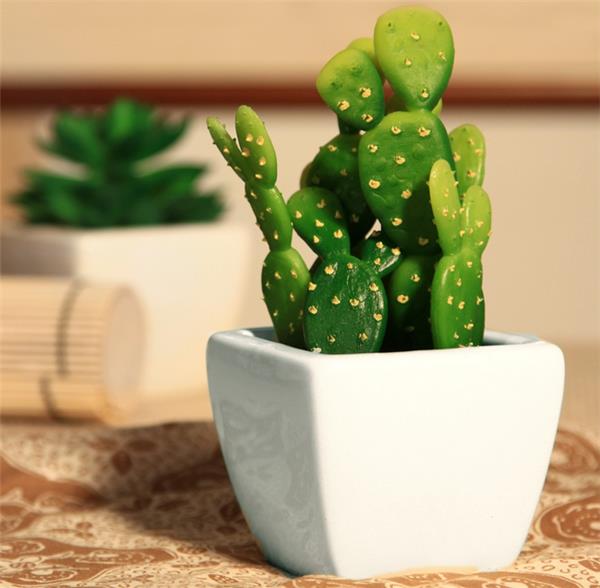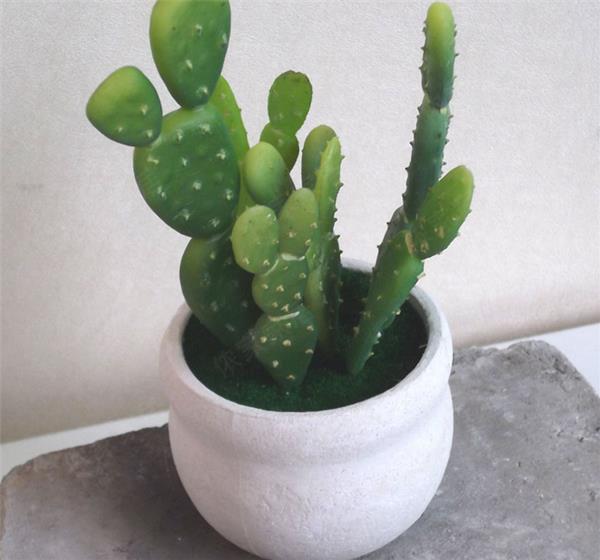How to cultivate cactus
Cactus is a desert plant, with strong drought tolerance, the following is to share with you how to cultivate cactus this problem, let's have a look!

How to cultivate cactus
I. watering and spraying
Terrestrial cactus has obvious growth period and dormant period, the growing period should be watered, the dormant period should be watered less or even no watering. For epiphytic type, if the winter temperature is kept above 12 ℃, it can be watered and sprayed all the year round; if the winter temperature is kept below 12 ℃, watering can be reduced and stopped. Water temperature should be close to soil temperature as far as possible, early (before sunrise) and late (after sunset) in summer, from 10:00 to 11:00 in winter, and directly onto basin soil, otherwise the appearance of thorns will be affected. In addition, it is necessary to sprinkle water on the ground in summer to increase air humidity.
II. Fertilization
Fertilization should grasp the following principles: timely, appropriate amount, depending on the object. Fertilization is carried out in spring and autumn, and once every 20 days, it should be carried out in the early morning or evening on a sunny day. If the basin soil is dry, sprinkle some water on the basin soil and then apply fertilizer with a concentration of 0.05%-0.2%. The effect is better if it is watered once the next morning. Terrestrial fertilization requires fertilizers rich in potassium and phosphorus and less nitrogen, while epiphytic fertilizers require more nitrogen fertilizer.
Third, lighting
Terrestrial type prefers plenty of sunshine, especially in winter. Generally, tall, cylindrical and flat cacti are more resistant to strong light and can be placed outdoors without sunshade in summer, while smaller spherical ones prefer semi-overcast conditions in summer, covering the top growing point of Jinzhu with a circular plastic film in June and August in summer high temperature season, so that all parts of the sphere can grow evenly. Epiphytic cacti require semi-overcast conditions all the year round.

4. Temperature
The suitable temperature for cactus growth is between 20 and 35 ℃. The terrestrial type does not require a high temperature during the dormancy period in winter, but the temperature can be maintained at 4: 7 ℃ while keeping the basin soil dry. Epiphytic type, however, requires a higher temperature in winter to maintain a temperature of 10-13 ℃ or higher. When the cactus reaches 30: 35 ℃ in summer, the growth rate of most cacti slows down, and sometimes some kinds of stems turn yellow or burn, so the sun must be shaded and more water must be sprinkled on the ground to lower the temperature.
5. Air
Cactus flowers are mostly native to desert open areas, with good ventilation and fresh air. Therefore, in the hot weather in midsummer, we should do a good job of ventilation and cooling in the cultivation site. The cultivation greenhouse should choose the environment of air circulation, and set up more vents such as windows and skylights, so as to ventilate and ventilate the hot summer weather. If necessary, equipment such as exhaust fans, hair dryers or electric fans can also be installed to enhance the air circulation effect of the environment, so as to promote cactus flowers to spend the summer safely.

VI. Diseases and insect pests
Bacteria and fungi are harmful to cactus flowers, but the problem is not very serious. As long as cultivation conditions are improved, management measures are appropriate, prevention and eradication of diseases and pests are applied at the same time, it is easy to achieve good results. The more common diseases and insect pests are:
1. Rot. The pathogens are bacteria and fungi. The occurrence of this disease is often related to improper watering, poor drainage of basin soil and persistent excessive dampness. After discovering the diseased plant, immediately cut off the diseased tissue with a sharp knife, and apply charcoal powder or sulfur powder to the incision, at the same time, control watering or changing pots, and carry out additional cutting or grafting. It is best to spray 40% copper oxychloride suspension 800-1000 times regularly on planting sites and plants as a precaution, but mainly to improve ventilation and avoid persistent excessive moisture.
2. Damage by insects and other animals. There are mainly shell insects, red spiders and slugs. To control scale insects, 50% omethoate emulsion can be sprayed 1000 times, red spiders can be sprayed with 20% dicofol wettable powder or 40% dicofol EC 1000 times, rodent and tide insects can be sprayed with 2000 times liquid, flower racks and around flowerpots can be sprayed with 2000 times liquid for snails and slugs, lime powder can be sprayed around flower pots, and 8% diclofenac granules can also be applied. To control cockroaches and ants, you can put drugs or sugar water to kill cockroaches and ants and kill trichlorfon.

Key points of cactus maintenance
The real cactus is really easy to raise, no matter it is watering or using the soil, but the cactus purchased by some students looks good on the surface, but actually has no roots, mainly reflected in the small potted plants bought by the roadside and the small potted plants bought in the flower market.
Although the cactus is a succulent plant, it is more drought-tolerant and will not die completely even if it is not watered for a month. But it must be watered for it to grow healthily. Winter: watering about every 20 days, the watering time is appropriate in the afternoon when the temperature is higher. If the living room is relatively dry, foliar spraying water can be used to keep the stem green. After the whole plant enters the dormant period, it can not be watered.
Spring: with the rise of the temperature, the number of watering can be increased appropriately, the principle of watering is not dry, watering is thorough; not too much watering, nor long-term non-watering. When the temperature rises to about 20 ℃, it is suitable to water once every 7-10 days.
Summer: high temperature, large evaporation, exuberant growth, is the season of the largest water demand for edible cactus, generally every 3-5 days need to be watered, when the temperature rises to more than 30 ℃, in order to maintain stem swelling pressure, increase ornamental, it is best to spray water on cactus stem 1-2 times every morning and evening.
Autumn: gradually decreasing. Watering potted plants should also pay attention to water temperature and water quality. Water is neutral or slightly PH acidic, it is best to use tap water for two days before use. In addition, watering had better be close to the indoor temperature, and more attention should be paid to potted edible cactus in cold areas in the north.
There is no need to be very particular about watering or using soil, but some students buy cacti that look good on the surface, but actually have no roots, mainly in the small potted plants bought by the roadside and the small potted plants purchased in the flower market.
Although the cactus is a succulent plant, it is more drought-tolerant and will not die completely even if it is not watered for a month. But it must be watered for it to grow healthily. Winter: watering about every 20 days, the watering time is appropriate in the afternoon when the temperature is higher. If the living room is relatively dry, foliar spraying water can be used to keep the stem green. After the whole plant enters the dormant period, it can not be watered.
Spring: with the rise of the temperature, the number of watering can be increased appropriately, the principle of watering is not dry, watering is thorough; not too much watering, nor long-term non-watering. When the temperature rises to about 20 ℃, it is suitable to water once every 7-10 days.
Summer: high temperature, large evaporation, exuberant growth, is the season of the largest water demand for edible cactus, generally every 3-5 days need to be watered, when the temperature rises to more than 30 ℃, in order to maintain stem swelling pressure, increase ornamental, it is best to spray water on cactus stem 1-2 times every morning and evening.
Autumn: gradually decreasing. Watering potted plants should also pay attention to water temperature and water quality. Water is neutral or slightly PH acidic, it is best to use tap water for two days before use. In addition, watering had better be close to the indoor temperature, and more attention should be paid to potted edible cactus in cold areas in the north.
Related
- Wuhan Hospital Iron Tree Blooming Result Was Instantly Frightened by the Gardener Master
- Which variety of camellia is the most fragrant and best? Which one do you like best?
- What is the small blue coat, the breeding methods and matters needing attention of the succulent plant
- Dormancy time and maintenance management of succulent plants during dormancy
- Minas succulent how to raise, Minas succulent plant pictures
- What are the varieties of winter succulent plants
- How to raise succulent plants in twelve rolls? let's take a look at some experience of breeding twelve rolls.
- Attention should be paid to water control for succulent plants during dormant period (winter and summer)
- Watering experience of twelve rolls of succulent plants
- Techniques for fertilizing succulent plants. An article will let you know how to fertilize succulent plants.



